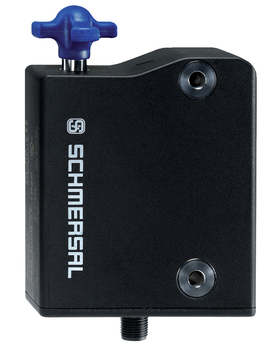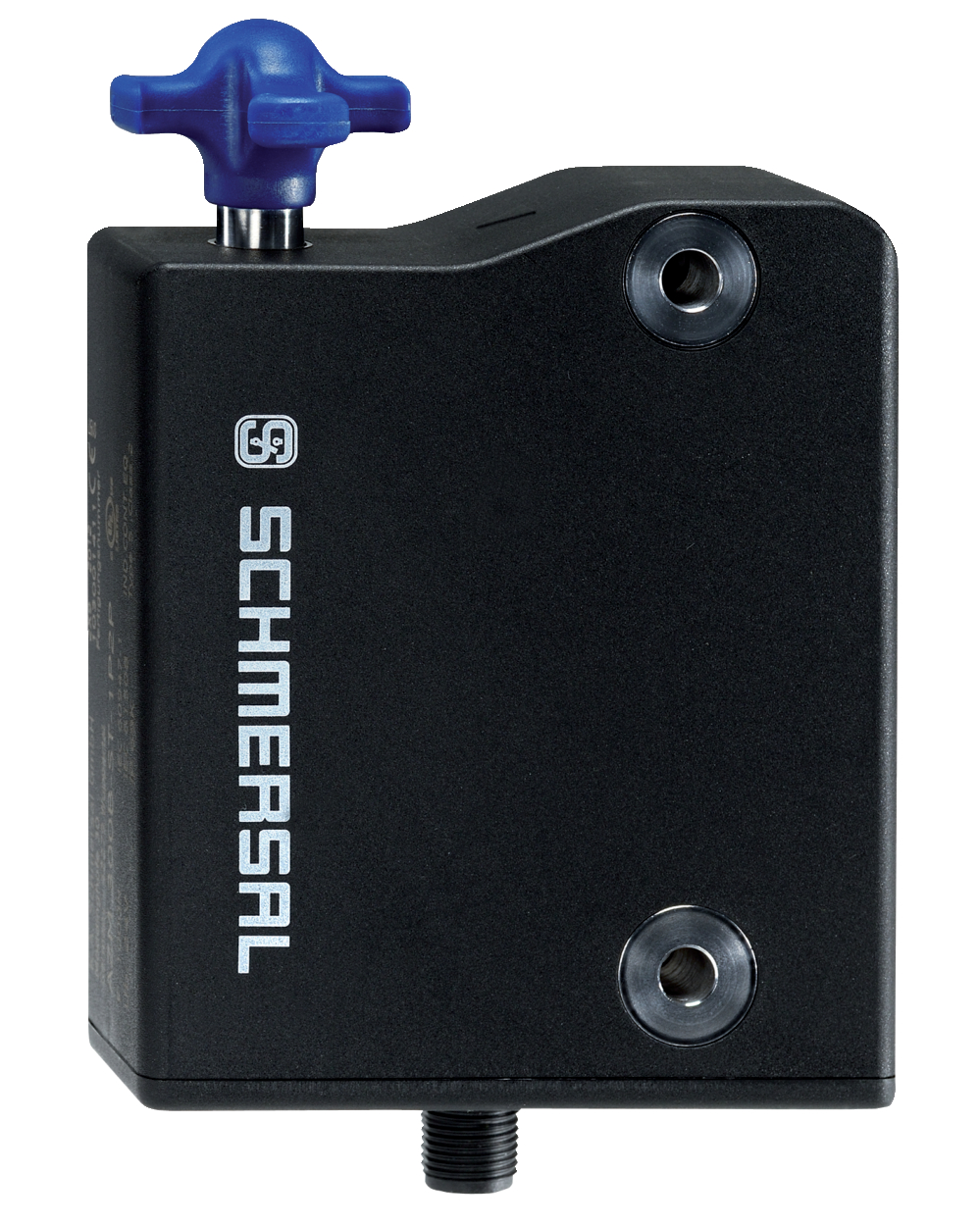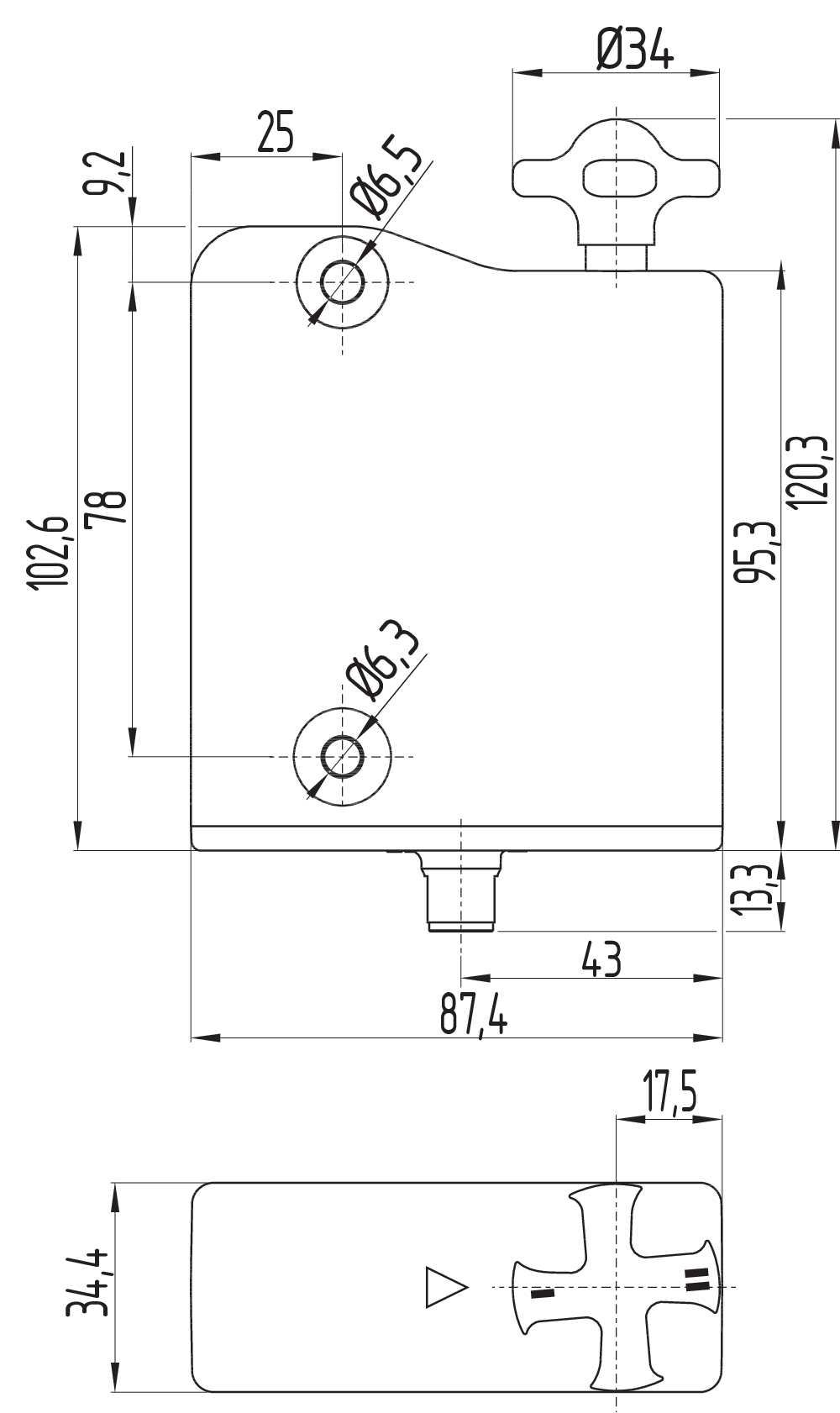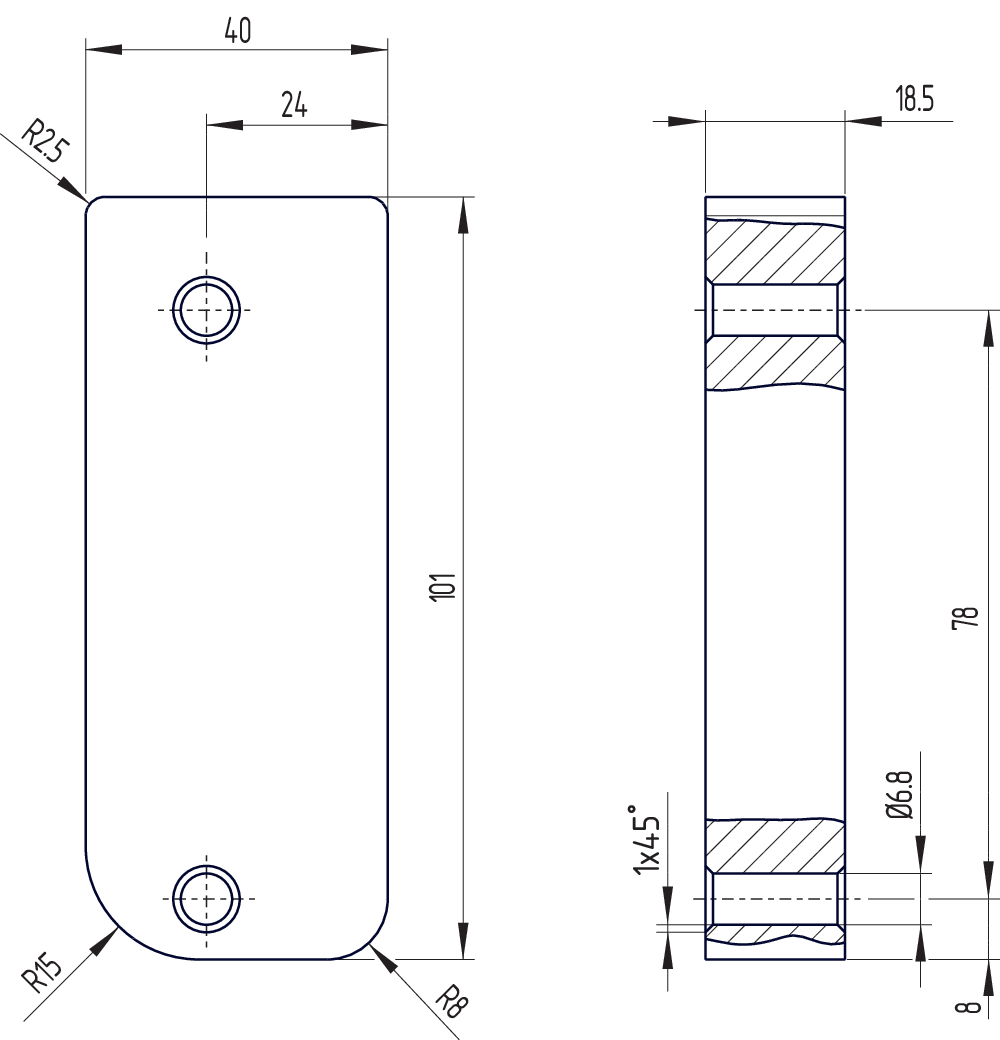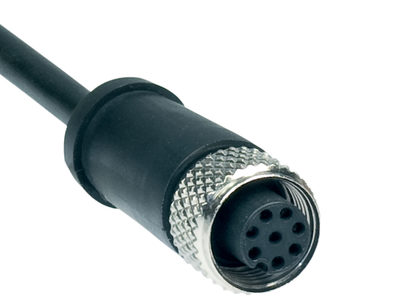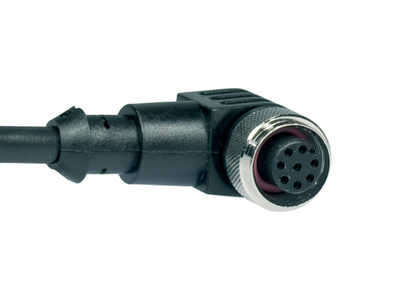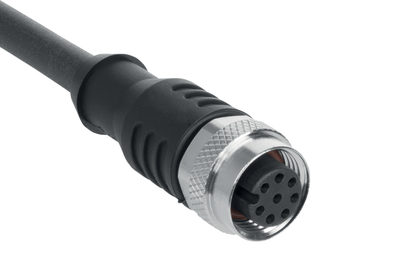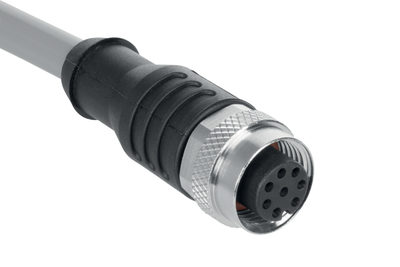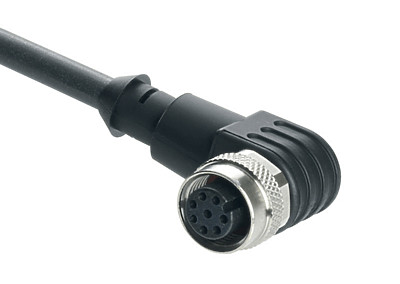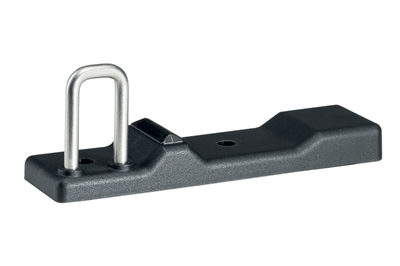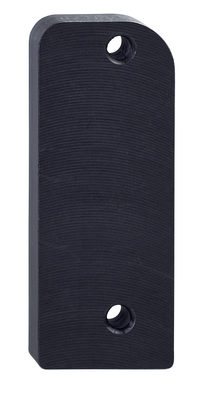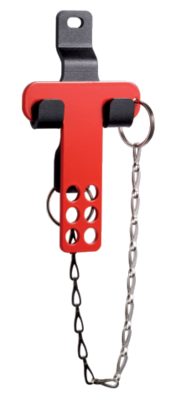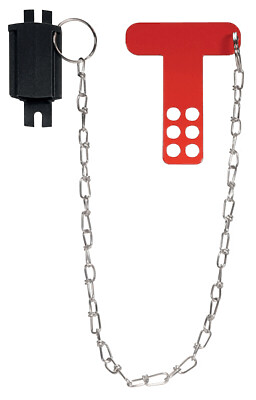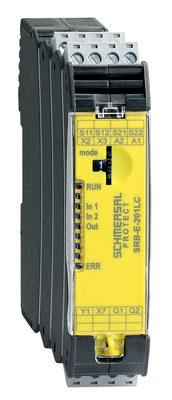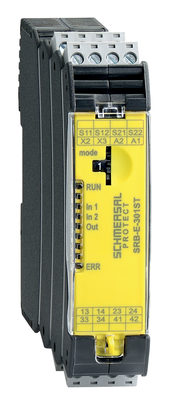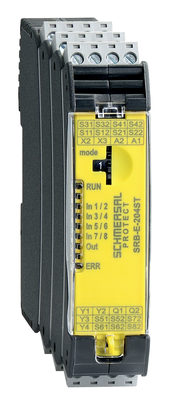AZM300Z-I1-ST-1P2P-A
AZM300Z-I1-ST-1P2P-A
| Descrição do tipo de produtos: AZM300(1)-(2)-ST-(3)-(4)-(5) |
| (1) | |
| Z | Supervisão de fechamento > |
| B | Supervisão de atuadores |
| (2) | |
| sem | Codificação Standard |
| I1 | Codificação individual |
| I2 | Codificação individual, aprendizagem múltipla |
| (3) | |
| 1P2P | 1 Saída de diagnóstico serial, tipo p e 2 Saídas de segurança , tipo p |
| SD2P | Saída de diagnóstico serial 2 Saídas de segurança , tipo p (PNP) |
| (4) | |
| sem | Princípio de travamento por mola |
| A | Princípio de travamento por corrente elétrica |
| (5) | |
| sem | Desbloqueio auxiliar |
| N | Destravamento de emergência |
| T | Dispositivo de destravamento de emergência (anti-pânico) |
| T 8 | Desbloqueio de emergência de fuga, distância 8,5 mm |
- Codificação individual com tecnologia RFID
- Nível de codificação ELEVADO de acordo com ISO 14119
- Conector M12, 8 polos
- Princípio de travamento por corrente elétrica
- Supervisão de fechamento
- Saída de diagnóstico
- design Higiênico
- Grau de proteção IP69
- Adequado para montagem em sistemas de perfil
- Invólucro em termoplástico
- Proteção contra manipulação conforme a necessidade graças à tecnologia RFID
- 3 direcções diferentes de acionamento
- Formato compacto
- 3 LED's para sinalizar as condições de operação
- Próprio para portas basculantes e corrediças
- Ligação em série
- Desbloqueio auxiliar
Código para encomenda
| Descrição do tipo de produtos |
AZM300Z-I1-ST-1P2P-A |
| Número de artigo (Número de encomenda) |
103001452 |
| EAN (European Article Number) |
4030661425986 |
| Número eCl@ss, versão 12.0 |
27-27-26-03 |
| Número eCl@ss, versão 11.0 |
27-27-26-03 |
| Número eCl@ss, versão 9.0 |
27-27-26-03 |
| Número ETIM, versão 7.0 |
EC002593 |
| Número ETIM, versão 6.0 |
EC002593 |
Homologações - Instruções
|
TÜV cULus ECOLAB FCC IC UKCA ANATEL |
Propriedades globais
| Instruções |
EN ISO 13849-1 EN ISO 14119 EN IEC 60947-5-3 EN IEC 61508 |
| informações gerais |
Codificação individual |
| Nível de codificação conforme EN ISO 14119 |
Alto |
| Princípio ativo |
RFID |
| Banda de frequência RFID |
125 kHz |
| Potência de envio RFID, máximo |
-6 dBm |
| Material do invólucro |
Plástico, termoplástico reforçado com fibra de vidro |
| Tempo de risco, máximo |
200 ms |
| Tempo de reação do atuador, máximo |
100 ms |
Tempo de reação das saídas de segurança em caso de desconexão pelas entradas de segurança, máximo |
1,5 ms |
| Peso bruto |
550 g |
Propriedades globais - Características
| Princípio de travamento por corrente elétrica |
Sim |
| Supervisão de fechamento |
Sim |
| Bloqueio |
Sim |
| Desbloqueio auxiliar |
Sim |
| Detecção de curto-circuito |
Sim |
| Reconhecimento de curto-circuitos |
Sim |
| Ligação em série |
Sim |
| Funções de segurança |
Sim |
| Indicação integrada, estado |
Sim |
| Número de direções de atuação |
3 |
| Quantidade de saídas digitais seguras |
2 |
Classificação
| Normas, regulamentos |
EN ISO 13849-1 EN IEC 61508 |
Classificação - função de solenoide adicional
| Performance Level, até |
e |
| Categoria de comando |
4 |
| Valor PFH |
5,20 x 10⁻¹⁰ /h |
| Valor PFD |
4,50 x 10⁻⁵ |
| Safety Integrity Level (SIL), apropriado na |
3 |
| Vida útil |
20 Ano(s) |
Classificação - função de bloqueio
| Performance Level, até |
d |
| Categoria de comando |
2 |
| Valor PFH |
2,00 x 10⁻⁹ /h |
| Valor PFD |
1,80 x 10⁻⁴ |
| Safety Integrity Level (SIL), apropriado na |
2 |
| Vida útil |
20 Ano(s) |
Dados mecânicos
| Mínima resistência mecânica |
1.000.000 comutações |
| Orientação (resistência mecânica) |
Para utilização como dobradiça de porta: ≥ 50.000 operações (para proteções ≤ 5 kg e velocidade do atuador ≤ 0,5 m/s) |
| Desalinhamento angular entre solenoide e atuador, máximo |
2 ° |
| Força de engate segundo a EN ISO 14119 |
1.150 N |
| Força de engate, máximo |
1.500 N |
| Força de retenção, ajustável, posição 1 |
25 N |
| Força de retenção, ajustável, posição 2 |
50 N |
| Versão dos parafusos de fixação |
2x M6 |
| Binário de aperto dos parafusos de fixação, mínimo |
6 Nm |
| Binário de aperto para parafusos de fixação, máximo |
7 Nm |
Mechanical data - Switching distances
| Distância do interruptor, típico |
2 mm |
| Distância do interruptor garantida "ON" |
1 mm |
| Distância do sensor garantida "OFF" |
20 mm |
| Nota (distância do interruptor) |
All switching distances in accordance EN IEC 60947-5-3 |
Dados mecânicos - dimensões
| Comprimento da corrente de sensores, máximo |
200 m |
| Nota (comprimento da cadeia de sensores) |
O comprimento e a secção do cabo alteram a queda de tensão em função da corrente de saída |
| Nota (ligação em série) |
Número ilimitado de dispositivos, respeitar a proteção externa do condutor, máx. 31 dispositivos com diagnóstico serial SD |
| Conexão, conector |
Conector M12, 8 polos, codificação-A |
Dados mecânicos - dimensões
| Comprimento do sensor |
120 mm |
| Largura de sensor |
87,5 mm |
| Altura do sensor |
35 mm |
Ambiente
| Tipo de proteção |
IP66 IP67 IP69 |
| Temperatura ambiente |
+0 ... +60 °C |
| Temperatura para armazenar e transportar |
-10 ... +90 °C |
| Máxima umidade relativa |
93 % |
| Orientação (humidade relativa) |
não condensado sem gelo |
| Resistência a vibrações conforme EN 60068-2-6: |
10 … 150 Hz, amplitude 0.35 mm |
| Resistência a impactos |
30 g / 11 ms |
| Classe de proteção |
III |
| Altura de instalação permitida sobre NN, máximo |
3.000 m |
Ambiente - Parâmetros de isolamento
| Medição de isolação da tensão |
32 VDC |
| Medição da rigidez dielétrica da tensão máxima |
0,8 kV |
| Categoria de sobre-tensão |
III |
| Grau de contaminação por sujeira conf. IEC 60947-1 |
3 |
Dados elétricos
| Tensão de operação |
24 VDC -15 % / +10 % (fonte de alimentação PELV) |
| Corrente de circuito aberto I0, típico |
100 mA |
| Consumo de corrente com o íman ON, valor médio |
200 mA |
| Consumo de corrente com íman ON, valor de pico |
350 mA / 200 ms |
| Medição da tensão de operação |
24 VDC |
| Corrente operacional nominal |
800 mA |
| Corrente de curto-circuito de acordo com EN 60947-5-1 {A} |
100 A |
| Isolação externa de cabos e equipamento |
2A gG |
| Atraso na operação, máximo |
5.000 ms |
| Frequência de comutação, máximo |
0,5 Hz |
| Categoria de aplicação DC-12 |
24 VDC / 0,05 A |
| Dados elétricos, máximo |
2 A |
Dados elétricos - Controle da bobina IN
| Designação, comando magnético |
IN |
| Limiares de comutação para entrada de ímãs |
-3 V … 5 V (Low) 15 V … 30 V (High) |
| Potência de consumo do controle magnético a 24 V |
10 mA |
| Ciclo de carga do íman |
100 % |
| Duração do impulso de teste, máximo |
5 ms |
| Intervalo do impulso de teste, mínimo |
40 ms |
| Classificação ZVEI CB24I, descida |
C0 |
| Classificação ZVEI CB24I, fonte |
C1 C2 C3 |
Dados elétricos - Entradas digitais seguras
| Designação, entradas de segurança |
X1 e X2 |
| Limiares de comutação para entradas de segurança |
−3 V … 5 V (Low) 15 V … 30 V (High) |
| Potência de consumo das entradas de segurança a 24 V |
5 mA |
| Duração do impulso de teste, máximo |
1 ms |
| Intervalo do impulso de teste, mínimo |
100 ms |
| Classificação ZVEI CB24I, descida |
C1 |
| Classificação ZVEI CB24I, fonte |
C1 C2 C3 |
Dados elétricos - Saída de segurança
| Designação, saídas de segurança |
Y1 e Y2 |
| Versão |
À prova de curto-circuito, tipo p |
| Queda de tensão Ud, máximo |
2 V |
| Corrente residual |
0,5 mA |
| Tensão, categoria de aplicação DC-12 |
24 VDC |
| Potência, categoria de aplicação DC-12 |
0,25 A |
| Tensão, categoria de aplicação DC-13 |
24 VDC |
| Potência, categoria de aplicação DC-13 |
0,25 A |
| Intervalo do impulso de teste, típico |
1000 ms |
| Duração do impulso de teste, máximo |
0,5 ms |
| Classificação ZVEI CB24I, fonte |
C2 |
| Classificação ZVEI CB24I, descida |
C1 C2 |
Dados elétricos - saída diagnóstico
| Designação, saídas de diagnóstico |
OUT |
| Versão |
À prova de curto-circuito, tipo p |
| Queda de tensão Ud, máximo |
2 V |
| Tensão, categoria de aplicação DC-12 |
24 VDC |
| Potência, categoria de aplicação DC-12 |
0,05 A |
| Tensão, categoria de aplicação DC-13 |
24 VDC |
| Potência, categoria de aplicação DC-13 |
0,05 A |
Indicação de Estado
| Orientação (LED indicador do estado) |
Estado operacional : LED amarelo Falha avaria funcional: LED vermelho Tensão de alimentação UB: LED verde indica |
Descrição dos pinos
| PIN 1 |
A1 Tensão de alimentação UB |
| PIN 2 |
X1 entrada de segurança 1 |
| PIN 3 |
A2 GND |
| PIN 4 |
Y1 Saída de segurança 1 |
| PIN 5 |
OUT Saída de diagnóstico |
| PIN 6 |
X2 entrada de segurança 2 |
| PIN 7 |
Y2 Saída de segurança 2 |
| PIN 8 |
IN Comando magnético |
Escopo do fornecimento
| Escopo do fornecimento |
O atuador não está incluído no fornecimento. |
Acessórios
| Recomendação (Atuador) |
AZ/AZM300-B1 |
Orientação
| Orientação (geral) |
Para portas que fecham rentes ao batente da porta, pode ser utilizada a placa de montagem opcional MP-AZ/AZM300-1. Para portas de vidro e Makrolon, pode ser utilizado o conjunto de montagem opcional MS-AZ/AZM300-B1-1. Desde que o atuador esteja inserido no encravamento, a porta que esta aberta pode ser encravada. Neste caso, as saídas de segurança são reativadas, de modo a que a proteção não tenha de ser aberta. |
Filtro de idioma
Ficha técnica
Manual de instruções e Declaração de conformidade (Breve)
Certificação UL
Certificação ECOLAB
Certificação UKCA
Certificação da inspeção da amostra do produto
ANATEL certification
Folheto
SISTEMA-VDMA Biblioteca/Library
Faça download da versão mais recente do Adobe Reader
Foto do produto (foto individual do catálogo )
Desenho dimensional componente básico
Desenho dimensional Outros
Disposição dos contatos
Exemplo de ligação
Video ID: azm300-07
Video ID: azm300-01
Video ID: azm300-06
Conteúdo
- 1 Sobre este documento
- 1.1 Função
- 1.2 A quem é dirigido o manual de instruções: pessoal técnico autorizado
- 1.3 Símbolos utilizados
- 1.4 Utilização correcta conforme a finalidade
- 1.5 Indicações gerais de segurança
- 2 Descrição do produto
- 2.1 Código para encomenda
- 2.2 Versões especiais
- 2.3 Descrição e utilização
- 2.4 Advertência contra utilização incorreta
- 2.5 Isenção de responsabilidade
- 2.6 Dados técnicos
- 3 Montagem
- 3.1 Instruções gerais de montagem
- 3.2 Desbloqueio auxiliar
- 3.3 Desbloqueio de emergência de fuga -T/-T8 ou Desbloqueio de emergência -N
- 3.4 Montagem com chapa de montagem
- 3.5 Dimensões
- 3.6 Atuador e acessórios
- 4 Ligação elétrica
- 4.1 Indicações gerais sobre a ligação elétrica
- 4.2 Diagnóstico série -SD
- 4.3 Exemplos de ligação em série
- 4.4 Configuração da conexão e acessórios do conector de encaixe
- 5 Codificação do atuador e ajuste da força de retenção
- 5.1 Codificação do atuador
- 5.2 Ajuste da força de retenção
- 6 Princípio de atuação e funções de diagnóstico
- 6.1 Comando do íman
- 6.2 Modo de trabalho das saídas de segurança
- 6.3 LED's de diagnóstico
- 6.4 Encravamento de segurança com saída de diagnóstico convencional
- 6.5 Encravamento com função de diagnóstico série SD
- 7 Colocação em funcionamento e manutenção
- 8 Desmontagem e eliminação
- 8.1 Desmontagem
- 8.2 Eliminação
1 Sobre este documento
1.1 Função
O presente documento fornece as informações necessárias para a montagem, a colocação em funcionamento, a operação segura e a desmontagem do dispositivo interruptor de segurança. O manual de instruções que se junta ao dispositivo deve ser mantido sempre em estado legível e guardado em local acessível.
1.2 A quem é dirigido o manual de instruções: pessoal técnico autorizado
Todos os procedimentos descritos neste manual devem ser executados apenas por pessoal formado e autorizado pelo utilizador do equipamento.
Instale e coloque o dispositivo em funcionamento apenas depois de ter lido e entendido o manual de instruções, bem como de se ter familiarizado com as normas de segurança no trabalho e prevenção de acidentes.
A seleção e montagem dos dispositivos, bem como a sua integração na técnica de comando, são vinculados a um conhecimento qualificado da legislação pertinente e requisitos normativos do fabricante da máquina.
Todas as informações são fornecidas sem garantia. Reservado o direito de alterações conforme o desenvolvimento tecnológico.
1.3 Símbolos utilizados
- Informação, dica, nota: Este símbolo identifica informações adicionais úteis.
- Cuidado: A não observação deste aviso de advertência pode causar avarias ou funcionamento incorreto.
Aviso: A não observação deste aviso de advertência pode causar danos pessoais e/ou danos na máquina.
1.4 Utilização correcta conforme a finalidade
A gama de produtos Schmersal não se destina a consumidores particulares.
Os produtos aqui descritos foram desenvolvidos para assumir funções voltadas para a segurança, como parte integrante de um equipamento completo ou máquina. Está na responsabilidade do fabricante do equipamento ou máquina assegurar o funcionamento correto do equipamento completo.
O dispositivo interruptor de segurança pode ser utilizado exclusivamente conforme as considerações a seguir ou para as finalidades homologadas pelo fabricante. Informações detalhadas sobre a área de aplicação podem ser consultadas no capítulo "Descrição do produto".
1.5 Indicações gerais de segurança
Devem ser observadas as indicações de segurança do manual de instruções bem como as normas nacionais específicas de instalação, segurança e prevenção de acidentes.
- Outras informações técnicas podem ser consultadas nos catálogos da Schmersal ou nos catálogos online na Internet em products.schmersal.com.
2 Descrição do produto
2.1 Código para encomenda
| Descrição do tipo de produtos: AZM300(1)-(2)-ST-(3)-(4)-(5) |
| (1) | |
| Z | Supervisão de fechamento > |
| B | Supervisão de atuadores |
| (2) | |
| sem | Codificação Standard |
| I1 | Codificação individual |
| I2 | Codificação individual, aprendizagem múltipla |
| (3) | |
| 1P2P | 1 Saída de diagnóstico série, tipo p e 2 Saídas de segurança , tipo p |
| SD2P | Saída de diagnóstico série e 2 Saídas de segurança , tipo p |
| (4) | |
| sem | Princípio de bloqueio por mola |
| A | Princípio de bloqueio por corrente elétrica |
| (5) | |
| sem | Desbloqueio auxiliar |
| N | Desbloqueio de emergência |
| T | Dispositivo de desbloqueio de emergência (anti-pânico) |
| T 8 | Desbloqueio de emergência de fuga, distância 8,5 mm |
2.2 Versões especiais
Para as versões especiais que não estão listadas no código de modelo, as especificações anteriores e seguintes aplicam-se de forma análoga, desde que sejam coincidentes com a versão de série.
2.3 Descrição e utilização
O dispositivo interruptor de segurança eletrónico sem contacto foi projetado para utilização em circuitos de segurança e para monitorizar e bloquear a posição de dispositivos de proteção móveis.
- Os dispositivos interruptores de segurança são classificados conforme EN ISO 14119 como tipo construtivo de 4 dispositivos de bloqueio. Versões com codificação individual estão classificados como altamente codificados.
As diversas variantes do dispositivo podem ser utilizadas como interruptor de segurança com função de bloqueio ou como solenóide de segurança.
- Se através da análise de risco for exigido um bloqueio monitorizado de forma segura , deve ser utilizada uma variante com monitorização do bloqueio no código de bloqueio, identificada com o símbolo >.
No caso da variante (B) monitorizada do atuador, trata-se de um interruptor de segurança com uma função de bloqueio para a proteção de processo.
A função de segurança consiste na paragem segura das saídas de segurança quando do bloqueio ou da abertura do dispositivo de proteção e, com o dispositivo de proteção aberto ou desbloqueado, da permanência segura em estado desligado das saídas de segurança.
- Encravamentos de segurança que funcionam segundo o princípio de bloqueio por corrente elétrica podem ser instalados apenas em casos especiais, depois de ser realizada uma análise criteriosa do risco de acidentes, visto que em caso de atuação do interruptor geral ou de queda de energia o dispositivo de proteção pode ser aberto diretamente.
É possível montar uma ligação em série. Numa ligação em série, o tempo de risco permanece inalterado e o tempo de reação eleva-se à soma do tempo de reação das entradas por dispositivo adicional indicado nos dados técnicos. O número de dispositivos é limitado apenas pelas perdas de cabo e a proteção do cabo externa, conforme os dados técnicos. É possível uma ligação em série de variantes de dispositivos com função de diagnóstico até 31 dispositivos.
- A avaliação e o dimensionamento da cadeia de segurança devem ser efetuados pelo utilizador em conformidade com as normas e regulamentos relevantes, de acordo com o nível de segurança requerido. Quando vários sensores de segurança participam da função de segurança, então os valores PFH dos componentes individuais devem ser somados.
- O conceito global do controlo, no qual o componente de segurança será integrado, deve ser validado segundo as normas relevantes.
2.4 Advertência contra utilização incorreta
- A utilização tecnicamente incorrecta ou quaisquer manipulações no interruptor de segurança podem ocasionar a ocorrência de perigos para pessoas e danos em partes da máquina ou equipamento. Observando-se as indicações de segurança, bem como as instruções de montagem, colocação em funcionamento, operação e manutenção, não são conhecidos riscos residuais.
2.5 Isenção de responsabilidade
Não assumimos nenhuma responsabilidade por danos e falhas operacionais causadas por erros de montagem ou devido à não observação deste manual de instruções. Também não é assumida qualquer responsabilidade adicional por danos causados pela utilização de peças sobressalentes ou acessórios não homologados pelo fabricante.
Por motivo de segurança não são permitidas quaisquer reparações, alterações ou modificações efetuadas por conta própria, nestes casos o fabricante exime-se da responsabilidade pelos danos resultantes.
2.6 Dados técnicos
Homologações - Instruções
|
TÜV cULus ECOLAB FCC IC UKCA ANATEL |
Propriedades globais
| Instruções |
EN ISO 13849-1 EN ISO 14119 EN IEC 60947-5-3 EN IEC 61508 |
| informações gerais |
Codificação individual |
| Nível de codificação conforme EN ISO 14119 |
Alto |
| Princípio ativo |
RFID |
| Banda de frequência RFID |
125 kHz |
| Potência de envio RFID, máximo |
-6 dBm |
| Material do invólucro |
Plástico, termoplástico reforçado com fibra de vidro |
| Tempo de risco, máximo |
200 ms |
| Tempo de reação do atuador, máximo |
100 ms |
Tempo de reação das saídas de segurança em caso de desconexão pelas entradas de segurança, máximo |
1,5 ms |
| Peso bruto |
550 g |
Propriedades globais - Características
| Princípio de travamento por corrente elétrica |
Sim |
| Supervisão de fechamento |
Sim |
| Bloqueio |
Sim |
| Desbloqueio auxiliar |
Sim |
| Detecção de curto-circuito |
Sim |
| Reconhecimento de curto-circuitos |
Sim |
| Ligação em série |
Sim |
| Funções de segurança |
Sim |
| Indicação integrada, estado |
Sim |
| Número de direções de atuação |
3 |
| Quantidade de saídas digitais seguras |
2 |
Classificação
| Normas, regulamentos |
EN ISO 13849-1 EN IEC 61508 |
Classificação - função de solenoide adicional
| Performance Level, até |
e |
| Categoria de comando |
4 |
| Valor PFH |
5,20 x 10⁻¹⁰ /h |
| Valor PFD |
4,50 x 10⁻⁵ |
| Safety Integrity Level (SIL), apropriado na |
3 |
| Vida útil |
20 Ano(s) |
Classificação - função de bloqueio
| Performance Level, até |
d |
| Categoria de comando |
2 |
| Valor PFH |
2,00 x 10⁻⁹ /h |
| Valor PFD |
1,80 x 10⁻⁴ |
| Safety Integrity Level (SIL), apropriado na |
2 |
| Vida útil |
20 Ano(s) |
Dados mecânicos
| Mínima resistência mecânica |
1.000.000 comutações |
| Orientação (resistência mecânica) |
Para utilização como dobradiça de porta: ≥ 50.000 operações (para proteções ≤ 5 kg e velocidade do atuador ≤ 0,5 m/s) |
| Desalinhamento angular entre solenoide e atuador, máximo |
2 ° |
| Força de engate segundo a EN ISO 14119 |
1.150 N |
| Força de engate, máximo |
1.500 N |
| Força de retenção, ajustável, posição 1 |
25 N |
| Força de retenção, ajustável, posição 2 |
50 N |
| Versão dos parafusos de fixação |
2x M6 |
| Binário de aperto dos parafusos de fixação, mínimo |
6 Nm |
| Binário de aperto para parafusos de fixação, máximo |
7 Nm |
Mechanical data - Switching distances
| Distância do interruptor, típico |
2 mm |
| Distância do interruptor garantida "ON" |
1 mm |
| Distância do sensor garantida "OFF" |
20 mm |
| Nota (distância do interruptor) |
All switching distances in accordance EN IEC 60947-5-3 |
Dados mecânicos - dimensões
| Comprimento da corrente de sensores, máximo |
200 m |
| Nota (comprimento da cadeia de sensores) |
O comprimento e a secção do cabo alteram a queda de tensão em função da corrente de saída |
| Nota (ligação em série) |
Número ilimitado de dispositivos, respeitar a proteção externa do condutor, máx. 31 dispositivos com diagnóstico serial SD |
| Conexão, conector |
Conector M12, 8 polos, codificação-A |
Dados mecânicos - dimensões
| Comprimento do sensor |
120 mm |
| Largura de sensor |
87,5 mm |
| Altura do sensor |
35 mm |
Ambiente
| Tipo de proteção |
IP66 IP67 IP69 |
| Temperatura ambiente |
+0 ... +60 °C |
| Temperatura para armazenar e transportar |
-10 ... +90 °C |
| Máxima umidade relativa |
93 % |
| Orientação (humidade relativa) |
não condensado sem gelo |
| Resistência a vibrações conforme EN 60068-2-6: |
10 … 150 Hz, amplitude 0.35 mm |
| Resistência a impactos |
30 g / 11 ms |
| Classe de proteção |
III |
| Altura de instalação permitida sobre NN, máximo |
3.000 m |
Ambiente - Parâmetros de isolamento
| Medição de isolação da tensão |
32 VDC |
| Medição da rigidez dielétrica da tensão máxima |
0,8 kV |
| Categoria de sobre-tensão |
III |
| Grau de contaminação por sujeira conf. IEC 60947-1 |
3 |
Dados elétricos
| Tensão de operação |
24 VDC -15 % / +10 % (fonte de alimentação PELV) |
| Corrente de circuito aberto I0, típico |
100 mA |
| Consumo de corrente com o íman ON, valor médio |
200 mA |
| Consumo de corrente com íman ON, valor de pico |
350 mA / 200 ms |
| Medição da tensão de operação |
24 VDC |
| Corrente operacional nominal |
800 mA |
| Corrente de curto-circuito de acordo com EN 60947-5-1 {A} |
100 A |
| Isolação externa de cabos e equipamento |
2A gG |
| Atraso na operação, máximo |
5.000 ms |
| Frequência de comutação, máximo |
0,5 Hz |
| Categoria de aplicação DC-12 |
24 VDC / 0,05 A |
| Dados elétricos, máximo |
2 A |
Dados elétricos - Controle da bobina IN
| Designação, comando magnético |
IN |
| Limiares de comutação para entrada de ímãs |
-3 V … 5 V (Low) 15 V … 30 V (High) |
| Potência de consumo do controle magnético a 24 V |
10 mA |
| Ciclo de carga do íman |
100 % |
| Duração do impulso de teste, máximo |
5 ms |
| Intervalo do impulso de teste, mínimo |
40 ms |
| Classificação ZVEI CB24I, descida |
C0 |
| Classificação ZVEI CB24I, fonte |
C1 C2 C3 |
Dados elétricos - Entradas digitais seguras
| Designação, entradas de segurança |
X1 e X2 |
| Limiares de comutação para entradas de segurança |
−3 V … 5 V (Low) 15 V … 30 V (High) |
| Potência de consumo das entradas de segurança a 24 V |
5 mA |
| Duração do impulso de teste, máximo |
1 ms |
| Intervalo do impulso de teste, mínimo |
100 ms |
| Classificação ZVEI CB24I, descida |
C1 |
| Classificação ZVEI CB24I, fonte |
C1 C2 C3 |
Dados elétricos - Saída de segurança
| Designação, saídas de segurança |
Y1 e Y2 |
| Versão |
À prova de curto-circuito, tipo p |
| Queda de tensão Ud, máximo |
2 V |
| Corrente residual |
0,5 mA |
| Tensão, categoria de aplicação DC-12 |
24 VDC |
| Potência, categoria de aplicação DC-12 |
0,25 A |
| Tensão, categoria de aplicação DC-13 |
24 VDC |
| Potência, categoria de aplicação DC-13 |
0,25 A |
| Intervalo do impulso de teste, típico |
1000 ms |
| Duração do impulso de teste, máximo |
0,5 ms |
| Classificação ZVEI CB24I, fonte |
C2 |
| Classificação ZVEI CB24I, descida |
C1 C2 |
Dados elétricos - saída diagnóstico
| Designação, saídas de diagnóstico |
OUT |
| Versão |
À prova de curto-circuito, tipo p |
| Queda de tensão Ud, máximo |
2 V |
| Tensão, categoria de aplicação DC-12 |
24 VDC |
| Potência, categoria de aplicação DC-12 |
0,05 A |
| Tensão, categoria de aplicação DC-13 |
24 VDC |
| Potência, categoria de aplicação DC-13 |
0,05 A |
Indicação de Estado
| Orientação (LED indicador do estado) |
Estado operacional : LED amarelo Falha avaria funcional: LED vermelho Tensão de alimentação UB: LED verde indica |
Descrição dos pinos
| PIN 1 |
A1 Tensão de alimentação UB |
| PIN 2 |
X1 entrada de segurança 1 |
| PIN 3 |
A2 GND |
| PIN 4 |
Y1 Saída de segurança 1 |
| PIN 5 |
OUT Saída de diagnóstico |
| PIN 6 |
X2 entrada de segurança 2 |
| PIN 7 |
Y2 Saída de segurança 2 |
| PIN 8 |
IN Comando magnético |
Notas sobre a certificação de segurança
- A certificação de segurança da função de retenção apenas é válida para aparelhos standard com função de retenção AZM300Z-...-1P2P-... monitorizada (comp. código de modelo). Uma certificação de segurança da função de bloqueio para dispositivos com diagnóstico serial "SD2P" através do SD-Gateway não é permitida devido ao sinal de bloqueio/desbloqueio não seguro.
- Caso numa utilização de uma versão de corrente de repouso não for possível usar um solenóide de segurança, neste caso excecional pode ser utilizado um bloqueio com princípio de bloqueio por corrente elétrica, quando são realizadas medidas adicionais de segurança, que estabelecem um nível de segurança equivalente.
- A certificação de segurança da função de retenção refere-se ao componente de retenção de segurança AZM em todo o sistema.
Por parte do cliente são necessárias outras medidas, como por exemplo, uma ativação segura e uma instalação de cabos segura para a exclusão de falhas.
Ao ocorrer uma falha, em que resulta um desbloqueio da função de retenção, isto é detetado pela função de retenção e as saídas de segurança Y1/Y2 desconectam com segurança. Ao ocorrer este tipo de falha seria possível a abertura imediata e única do dispositivo de segurança antes de alcançar o estado seguro da máquina. O comportamento do sistema da categoria 2 permite, que entre os testes, a ocorrência da falha cause a perda da função de segurança e a perda da função de segurança é detetada com o teste.
- A ativação do comando deve ser comparada externamente com a habilitação OSSD. Se ocorrer aqui uma desconexão devido a um desbloqueio involuntário, isto é descoberto pelo diagnóstico externo.
Orientação UL
- Este dispositivo foi projetado para a alimentação de corrente por uma fonte listada com tensão limitada, corrente limitada ou da Classe 2. Este dispositivo deve ser alimentado com corrente contínua de, no mínimo, 24 V e 0,8 A através de um módulo de cabos/conectores (CYJV) listado.
FCC/IC - Nota
Este dispositivo está em conformidade com a secção 15 das diretivas da Federal Communications Commission (FCC) e contém transmissores/recetores isentos de licença que estão em conformidade com a(s) norma(s) RSS do ISED (Innovation, Science and Economic Development) do Canadá.
O funcionamento está sujeito às duas condições seguintes:
(1) Este dispositivo não pode emitir sinais de interferência prejudiciais e
(2) Este dispositivo deve poder tolerar sinais de interferência. Estes incluem também sinais de interferência que podem causar um funcionamento não desejado do dispositivo.
A uma distância mínima de 100 mm durante o funcionamento, este dispositivo respeita os valores limite para estimulação nervosa (ISED SPR-002). Alterações ou adaptações que não tenham sido expressamente aprovadas pela K.A. Schmersal GmbH & Co. KG podem anular a autorização do utilizador para operar o dispositivo.
O transmissor/recetor isento de licença integrado neste dispositivo cumpre os requisitos em vigor da "Radio Standards Specification" da organização Innovation, Science and Economic Development Canada (ISED) aplicáveis a equipamentos de rádio. O funcionamento é permitido nas duas seguintes condições:
(1) O dispositivo não pode criar interferências.
(2) O dispositivo deve suportar as interferências de rádio recebidas, mesmo que estas possam prejudicar o seu modo de funcionamento.
Este dispositivo cumpre os requisitos de valores limites de exposição para estimulação do tecido nervoso (ISED CNR-102) em processos com uma distância mínima de 100 mm.
No caso de alterações ou modificações que não tenham sido expressamente autorizadas pela K.A. Schmersal GmbH & Co. KG, a autorização do utilizador para operar o dispositivo pode ser invalidada.
3 Montagem
3.1 Instruções gerais de montagem
- Favor observar as indicações relacionadas nas normas EN ISO 12100, EN ISO 14119 e EN ISO 14120.
Para a fixação do encravamento de segurança e do atuador existem dois furos para parafusos M6 (Binário de aperto: 6 … 7 Nm).
A posição de uso é opcional. A operação do sistema é permitida apenas com a manutenção de um ângulo ≤ 2° entre o solenóide e o atuador.

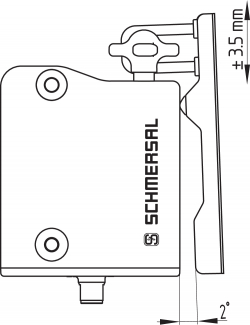
- O encravamento de segurança pode ser usado como batente. Dependendo da massa da porta e da velocidade de atuação, pode ocorrer uma redução da vida útil mecânica.
Montagem das unidades de atuador
Ver o manual de instruções da respetiva unidade de atuador.
- O atuador deve ser fixado de modo que não possa ser solto (utilização de parafusos não amovíveis, adesivo, furação, pinos de fixação) do dispositivo de proteção e travado contra deslocamento.
Direções de atuação


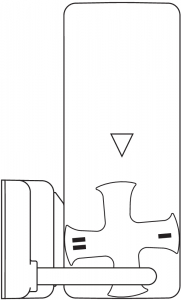
As figuras apresentam um dispositivo de segurança fechado com uma força de retenção ajustada de 50 N (ver também o capítulo "Ajuste da força de retenção").
- Assegurar uma intervenção suficiente do atuador na manivela de cruz .
Certo

Errado
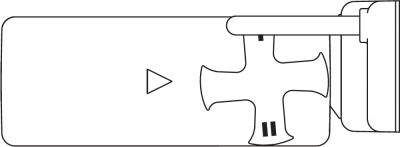
Para evitar uma influência causada pelo sistema bem como a redução das distâncias de comutação, por favor observar as seguintes indicações:
- Peças metálicas nas proximidades do dispositivo interruptor de segurança podem alterar a distância de comutação.
- Manter longe de aparas de metal.
Distância mínima entre duas retenções de segurança
ou outros sistemas com mesma frequência (125 kHz)

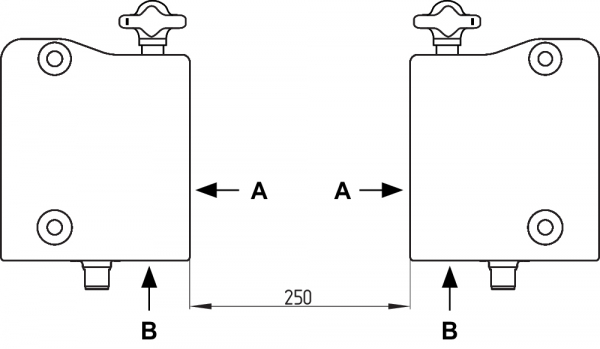
A distância mínima das superfícies de fixação metálicas para o lado frontal "A" e para a parte inferior "B" do aparelho é 5 mm.


3.2 Desbloqueio auxiliar
Para a instalação da máquina, a retenção de segurança pode ser desenergizada para desbloquear. Ao girar o desbloqueio auxiliar para a posição q a retenção de segurança é desbloqueada. Apenas depois de girar o desbloqueio auxiliar de volta para a posição inicial p , a função de bloqueio normal é reposta.
Atenção: não girar para além do batente!

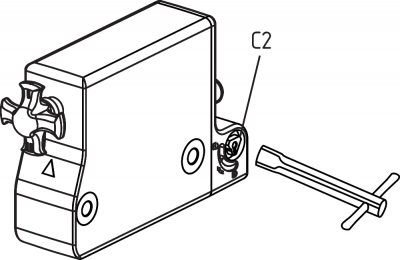
Legenda
A: Conector incorporado M12, 8 polos
B: Indicação LED
C1: Desbloqueio auxiliar com chave de fendas
C2: Desbloqueio auxiliar através de chave triangular TK-M5
Após a colocação em funcionamento, o desbloqueio auxiliar deve estar protegido contra ativação involuntária, ou pela utilização de um lacre anexo.
3.3 Desbloqueio de emergência de fuga -T/-T8 ou Desbloqueio de emergência -N
Nas variantes com desbloqueio de emergência de fuga e desbloqueio de emergência, a alavanca vermelha é fornecida solta. A alavanca deve ser assim, após a primeira colocação em funcionamento, montada com o parafuso anexo no triângulo do desbloqueio, de forma que a seta no triângulo e a espiga da alavanca vermelha coincidam.
A montagem da alavanca é possível de ambos os lados. O lado oposto pode ser usado como desbloqueio auxiliar utilizando a chave triangular TK-M5.
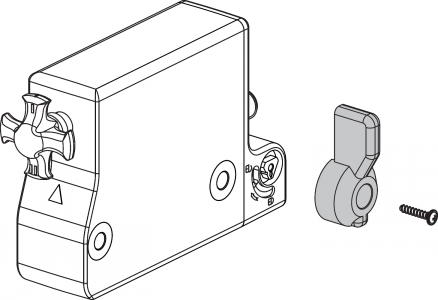
- A reposição do desbloqueio auxiliar acionando a alavanca de desbloqueio de fuga deve ser excluída pelo utilizador.
- Desbloqueio de emergência de fuga (-T/-T8)
Montagem e atuação apenas dentro da zona de perigo.
Para o desbloqueio de emergência de fuga rodar a alavanca vermelha em sentido da seta até ao batente. As saídas de segurança são desativadas e o dispositivo de proteção pode ser aberto nesta posição. A posição de bloqueio é anulada girando-se a alavanca de volta na direção contrária. Na posição desbloqueada, o dispositivo de proteção está protegido contra bloqueio acidental.
- Desbloqueio de emergência (-N)
Montagem e atuação apenas fora da zona de perigo. O desbloqueio de emergência apenas deve ser utilizado em caso de emergência. O bloqueio de segurança deve ser aplicado e/ou protegido de forma que uma abertura involuntária do bloqueio seja evitada através do desbloqueio de emergência. O desbloqueio de emergência deve estar visivelmente identificado com a indicação de que apenas deve ser utilizado em caso de emergência. Para tal, pode ser utilizado o autocolante fornecido.
Para o desbloqueio de emergência rodar a alavanca vermelha em sentido da seta até ao batente. As saídas de segurança são desativadas e o dispositivo de proteção pode ser aberto nesta posição. A alavanca fica engatada e não é possível girá-la de volta. Para anular a posição de bloqueio é necessário girar o parafuso central para fora até que a posição de bloqueio seja suspensa. Girar a alavanca de volta à sua posição inicial e apertar novamente o parafuso.
- Para garantir uma função correta do desbloqueio de emergência de fuga -T/-T8 e do desbloqueio de emergência -N, a porta de proteção não se deve encontrar num estado mecanicamente tensionado.
- É possível a combinação de um desbloqueio de emergência de fuga e um desbloqueio de emergência. Observe que ao acionar a alavanca vermelha, a alavanca do lado oposto também roda. Assim, o procedimento descrito acima é necessário para cancelar a posição travada da alavanca do desbloqueio de emergência.
3.4 Montagem com chapa de montagem
Para portas que fecham alinhadas com o caixilho da porta, pode ser utilizada a chapa de montagem opcional MP-AZ/AZM300-1.

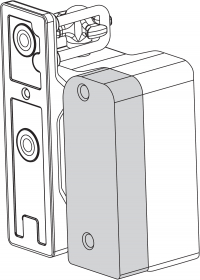
3.5 Dimensões
Todas as medidas em mm.

AZM300...-T/-T8 ou -N
Dispositivos com desbloqueio de fuga de emergência ou desbloqueio de emergência
Desbloqueio de fuga em emergência -T / Desbloqueio de emergência -N
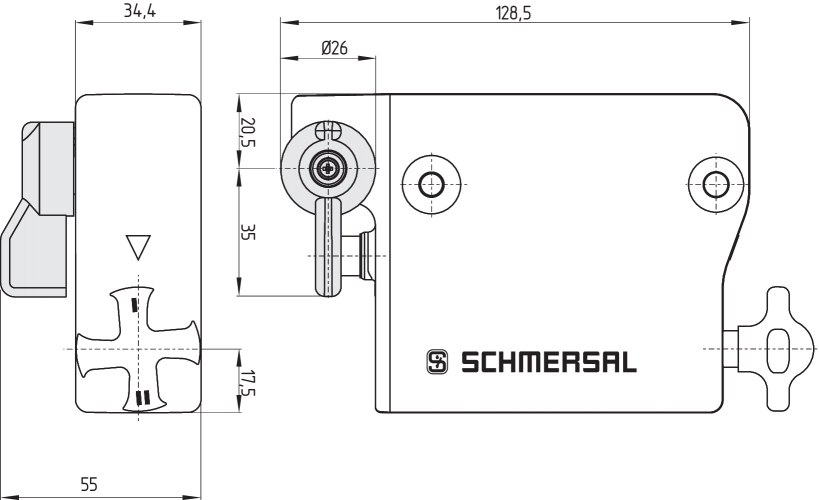
Desbloqueio de emergência de fuga -T8

3.6 Atuador e acessórios
Atuador AZ/AZM300-B1 (não incluído no fornecimento)
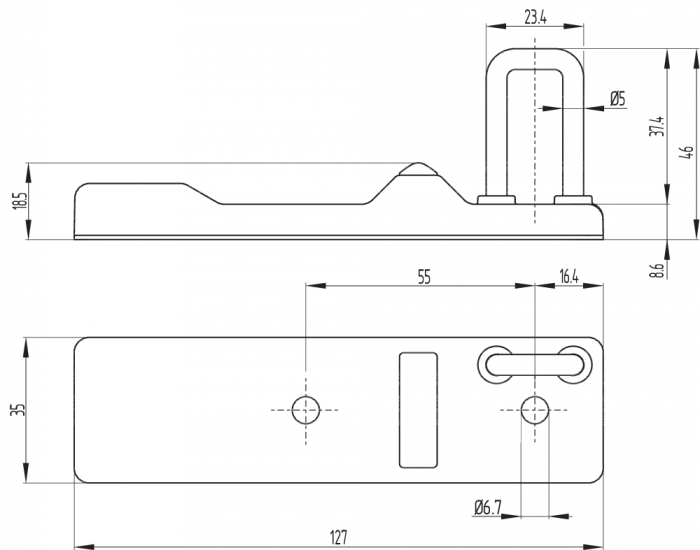
Placa de montagem MP-AZ/AZM300-1 (disponíveis como acessórios)

MS-AZ/AZM300-B1-1 (disponível como acessórios)
Chapa de proteção de alumínio como anteparo de visão para aplicação em portas de vidro ou de material sintético com elevados requisitos de design.
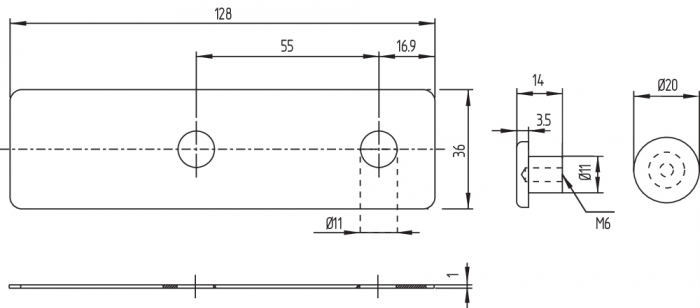
Bloqueador SZ 200-1 (disponíveis como acessórios)

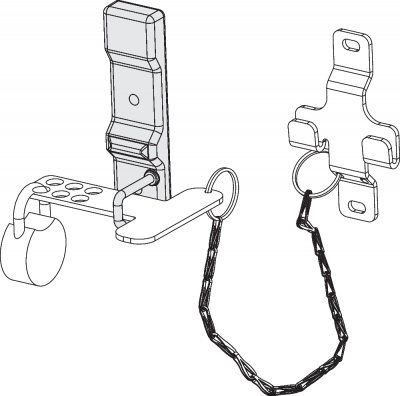
Desbloqueio de cabo Bowden ACC-AZM300-BOW-.-.M-.M (disponível como acessório)
As indicações adicionais do manual de instruções para o desbloqueio do cabo Bowden devem ser observadas.

4 Ligação elétrica
4.1 Indicações gerais sobre a ligação elétrica
- A ligação elétrica pode ser efetuada apenas em estado desenergizado por pessoal técnico autorizado.
As entradas de tensão A1, X1, X2 e IN devem ser protegidas contra sobretensão permanente. Por isso devem ser utilizadas fontes de alimentação PELV conforme EN 60204-1.
A proteção do cabo elétrico necessária deve ser fornecido na instalação.
As saídas de segurança podem ser utilizadas diretamente para a interligação da parte do comando do utilizador relevante para a segurança.
Requisitos exigidos de uma unidade de avaliação subsequente:
Entrada de segurança de dois canais, adequada para saídas de semicondutores tipo 2p
- Configuração comando de segurança
Na ligação do sensor de segurança nas unidades de avaliação de segurança eletrónicas, recomendamos o ajuste de um período mínimo de 100 ms de discrepância. As entradas de segurança da unidade de avaliação têm de poder ocultar um impulso de teste de aprox. 1 ms. Não é necessária uma deteção de curto-circuito na unidade de avaliação, se for o caso esta deve ser desligada.
- Informações técnicas acerca da seleção de módulos de avaliação de segurança adequados podem ser consultadas nos catálogos da Schmersal ou no catálogo online na Internet em products.schmersal.com.
4.2 Diagnóstico série -SD
Dimensionamento do cabo
O cabo ligado a um encravamento de segurança com função de diagnóstico serial não deve exceder a capacitância de 50 nF. Cabos de comando comuns sem blindagem LIVY 0,25 mm² até 1,5 mm² com 30 m de comprimento possuem, dependendo da estrutura de fiação, uma capacitância de aprox. 3 … 7 nF.
- Quando da cablagem dos dispositivos SD favor observar queda de tensão nos condutores e a capacidade condutora de cada componente individual.
- Acessórios para a ligação em série
Para facilitar uma cablagem e ligação em série de dispositivos SD estão disponíveis os distribuidores SD PFB-SD-4M12-SD (variante para o nível de campo) e PDM-SD-4CC-SD (variante para o armário de distribuição, pode ser montado sobre perfil de suporte) bem como, outros acessórios abrangentes. Informação detalhada em products.schmersal.com.
4.3 Exemplos de ligação em série
É possível montar uma ligação em série. Numa ligação em série, o tempo de risco permanece inalterado e o tempo de reação eleva-se à soma do tempo de reação das entradas por dispositivo adicional indicado nos dados técnicos. O número de dispositivos é limitado apenas pelas perdas de cabo e a proteção do cabo externa, conforme os dados técnicos. É possível uma ligação em série de AZM300…-SD com função de diagnóstico série com um número de até 31 dispositivos.
Os exemplos de aplicação mostrados são sugestões que não eximem o utilizador de verificar a ligação quanto à sua respetiva adequação para cada caso individual.
Exemplo de ligação 1: Ligação em série do interruptor de segurança AZM300 com saída de diagnóstico convencional
A tensão é alimentada no último dispositivo interruptor de segurança da cadeia (visto a partir da unidade de avaliação) nas duas entradas de segurança. As saídas de segurança do primeiro dispositivo interruptor de segurança são conduzidas para a unidade de avaliação.
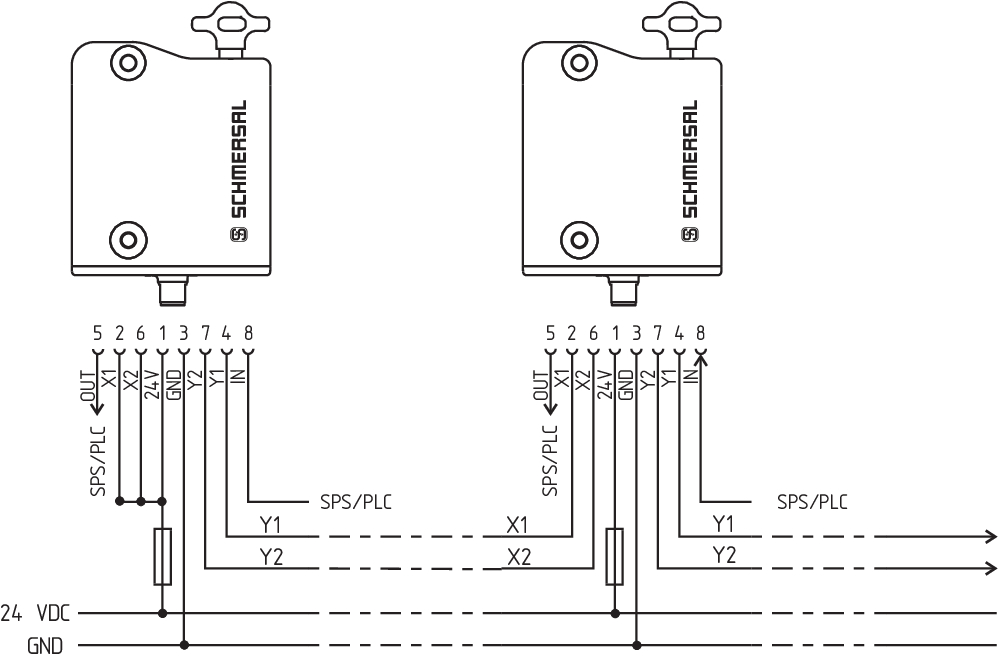
Y1 e Y2 = saídas de segurança → unidade de avaliação
Exemplo de ligação 2: Ligação em série do AZM300 com função de diagnóstico série (máx. 31 dispositivos em série)
Em dispositivos com uma função de diagnóstico série (índice de encomenda SD). As ligações de diagnóstico série são ligadas em série para avaliação em um Gateway SD. As saídas de segurança do primeiro dispositivo interruptor de segurança são conduzidas para a unidade de avaliação. O Gateway série de diagnóstico é ligado à entrada de diagnóstico série do primeiro dispositivo interruptor de segurança.
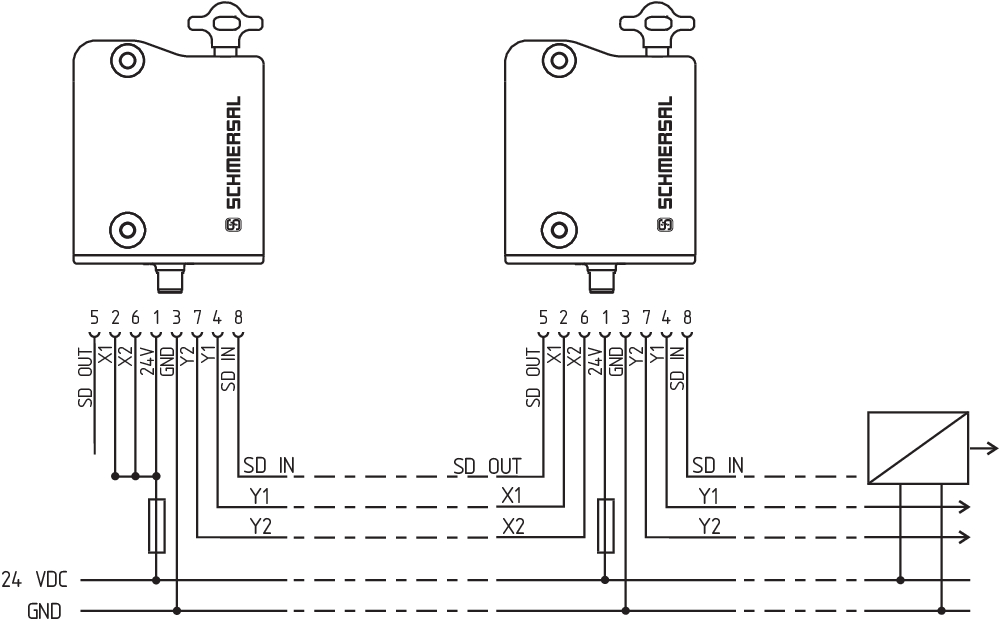
Y1 e Y2 = saídas de segurança → unidade de avaliação
SD-IN → Gateway → bus de campo
4.4 Configuração da conexão e acessórios do conector de encaixe
| Função de dispositivo interruptor de segurança | Pinagem do conector incorporado | Códigos de cores dos conectores de encaixe Schmersal | Possíveis códigos de cores de outros conectores de encaixe disponíveis no mercado Código de cores de outros conectores de encaixe disponíveis no mercado conforme EN 60947-5-2 | |||
|---|---|---|---|---|---|---|
| com saída de diagnóstico convencional | com função de diagnóstico série |  | IP67 / IP69 conforme DIN 47100 | IP69 (PVC) | ||
| A1 | Ue | 1 | WH | BN | BN | |
| X1 | Entrada de segurança 1 | 2 | BN | WH | WH | |
| A2 | GND | 3 | GN | BU | BU | |
| Y1 | Saída de segurança 1 | 4 | YE | BK | BK | |
| OUT | Saída para diagnóstico | Saída SD | 5 | GY | GY | GY |
| X2 | Entrada de segurança 2 | 6 | PK | VT | PK | |
| Y2 | Saída de segurança 2 | 7 | BU | RD | VT | |
| IN | Controlo do solenóide | SD Entrada | 8 | RD | PK | OR |
| Sinal | PIN | Conector (2) | Cores dos fios | |||
|---|---|---|---|---|---|---|
| Cabo↲SCHMERSAL | Cabo de acordo com ↲EN 60947-5-2 | Cabo de acordo com ↲DIN 47100 | ||||
| A1 | 1 | Ue | BN | BN | WH |  |
| A1 | 2 | Ue | WH | WH | BN | |
| A2 | 3 | GND | BU | BU | GN | |
| A2 | 4 | GND | BK | BK | YE | |
| Y1 | 5 | Saída de segurança 1 | GY | GY | GY | |
| Y2 | 6 | Saída de segurança 2 | VT | PK | PK | |
| IN | 7 | SD Entrada | RD | VT | BU | |
| OUT | 8 | Saída SD | PK | OR | RD | |
Configuração da ligação diferente quando se utiliza o distribuidor em Y CSS-Y-8P para ligação ao Gateway SD.
| Condutor de ligação com acoplamento (fêmea) IP67 / IP69, M12, 8-polos - 8 x 0,25 mm² conforme DIN 47100 | |
|---|---|
| Comprimento do condutor | Código de encomenda |
| 2,5 m | 103011415 |
| 5,0 m | 103007358 |
| 10,0 m | 103007359 |
| 15,0 m | 103011414 |
| Condutores de ligação (PVC) com tomada (fêmea) M12, 8 polos - 8 x 0,21 mm², IP69 | |
|---|---|
| Comprimento do condutor | Código de encomenda |
| 5,0 m | 101210560 |
| 5,0 m, angular | 101210561 |
| 10,0 m | 103001389 |
| 15,0 m | 103014823 |
5 Codificação do atuador e ajuste da força de retenção
5.1 Codificação do atuador
Solenóides de segurança com codificação standard estão prontos a funcionar no estado de fornecimento.
Solenóides de segurança e atuadores codificados individualmente passam por aprendizagem mútua conforme a sequência a seguir:
- Desligar o solenóide de segurança e realimentar com tensão.
- Colocar o atuador na área de captação. O processo de aprendizagem é sinalizado no solenóide de segurança, LED verde desligado, LED vermelho aceso, LED amarelo intermitente (1 Hz).
- Após 10 segundos, pulsos de pisca-pisca em ciclo mais curto (3 Hz) pedem o desligamento da tensão de operação do solenóide de segurança. (Caso o desligamento não seja efetuado dentro de 5 minutos, o solenóide de segurança interrompe o processo de aprendizagem e sinaliza um atuador errado piscando 5x vermelho.)
- Ao religar a tensão de operação, o atuador tem de ser novamente captado para ativar o código de atuador aprendido. O código ativado é então guardado definitivamente.
Na opção de encomenda -I1 a atribuição assim efetuada entre o dispositivo interruptor de segurança e atuador é irreversível.
Na opção de encomenda -I2 o processo de aprendizagem para um novo atuador pode ser repetido de modo ilimitado. Quando da aprendizagem de um novo atuador, o código anterior é eliminado. De seguida, um bloqueio de habilitação de dez minutos assegura uma elevada proteção contra manipulação. O LED verde pisca até decorrer o tempo do bloqueio de habilitação e o novo atuador ser captado. Em caso de interrupção da alimentação de tensão durante o decurso dos 10 minutos de proteção contra manipulação, posteriormente a contagem é reiniciada.
5.2 Ajuste da força de retenção
Para o perfeito funcionamento do dispositivo de proteção, quando este está aberto a manivela de cruz deve ficar na posição I ou II. Nas posições intermédias o bloqueio não é possível. Ao girar a manivela de cruz em 180°, a força de retenção é alterada.
Na posição I a força de retenção é de aprox. 25 N.
Na posição II a força de retenção é de aprox. 50 N.

6 Princípio de atuação e funções de diagnóstico
6.1 Comando do íman
Na variante de corrente de repouso do AZM300, o solenóide é desbloqueado quando da ativação do sinal IN (= 24 V) durante a operação. Na variante de corrente de trabalho do AZM300, o solenóide é bloqueado quando da ativação do sinal IN (= 24 V) durante a operação.
6.2 Modo de trabalho das saídas de segurança
Na versão AZM300Z, o desbloqueio do solenóide de segurança causa a paragem das saídas de segurança. O dispositivo de proteção desbloqueado pode ser novamente bloqueado enquanto o atuador permanecer inserido no solenóide de segurança AZM300Z, então as saídas de segurança são religadas.
Não é necessário abrir o dispositivo de proteção.
Na versão AZM300B, apenas a abertura do dispositivo de proteção leva à paragem das saídas de segurança.
6.3 LED's de diagnóstico
O solenóide de segurança sinaliza a condição de operação, mas também avarias, através de três LED's com cores diferentes.
| Verde (Potência) | Tensão de alimentação presente |
| Amarelo (Estado) | condição de operação |
| Vermelho (Falha) | Falha (v. tabela 2: mensagens de falha / códigos de luz intermitente LED de diagnóstico vermelho) |
| Estado do sistema Sem sinal de entrada em X1 e/ou X2 | LED | ||
|---|---|---|---|
| Verde | Vermelho | Amarelo | |
| Porta aberta e uma porta na ligação em série anterior também está aberta | intermitente (1Hz) | desliga | desliga |
| Porta fechada e uma porta na ligação em série anterior aberta | intermitente (1Hz) | desliga | intermitente |
| Porta bloqueada e uma porta na ligação em série anterior está aberta | intermitente (1Hz) | desliga | liga |
6.4 Encravamento de segurança com saída de diagnóstico convencional
A saída de diagnóstico OUT, à prova de curto-circuito, pode ser utilizado para indicação centralizada ou funções de controlo, ex. num PLC.
A saída de diagnóstico não é uma saída de segurança!
Falhas
As falhas que deixam de assegurar o funcionamento seguro do dispositivo interruptor de segurança (falhas internas) causam o desligamento das saídas de segurança dentro do tempo de risco. Depois de eliminada a falha, a mensagem de falha é confirmada com a abertura da respetiva porta de proteção e o encerramento da mesma.
Alerta de falha
Uma falha que não prejudica momentaneamente o funcionamento seguro do dispositivo interruptor de segurança (p. ex., temperatura ambiente demasiado elevada, saída de segurança para potencial externo, circuito cruzado) provoca um desligamento retardado (ver tabela 2). A combinação de sinal "saída de diagnóstico desligada" e "saídas de segurança ainda ligadas" pode ser utilizada para deslocar a máquina até uma posição de paragem ordenada.
Se a causa for eliminada, o alerta de falha é suprimido.
Se o alerta de falha se mantiver durante 30 minutos, são desligadas também as saídas de segurança (o LED vermelho pisca, ver tabela 2).
Comportamento da saída de diagnóstico no exemplo de um solenóide com princípio de bloqueio por mola
Sinal de entrada comando magnético

Sequência normal, a porta foi bloqueada

Porta não pôde ser bloqueada ou falha

 | Porta foi aberta |  | Porta foi fechada |  | Tempo de bloqueio |
 | Porta não bloqueada ou falha |  | Proteção de segurança encravada | ||
 | Bloquear |  | Desbloquear |
Avaliação da saída de diagnóstico

Corrente de repouso: IN = 0 = bloquear
 | Porta pode ser bloqueada |
 | Porta está bloqueada |
Corrente elétrica: IN = 1 = bloquear
 | Porta pode ser bloqueada |
 | Porta está bloqueada |
| Tabela 1: Informações de diagnóstico do dispositivo interruptor de segurança | ||||||||
|---|---|---|---|---|---|---|---|---|
| Estado do sistema | Comando magnético IN | LED | Saídas de segurança Y1, Y2 | Saída de diagnóstico OUT | ||||
| Desbloqueio tensão | Bloqueio por tensão | Verde | Vermelho | Amarelo | AZM300Z | AZM300B | ||
| Porta aberta | 24 V (0 V) | 0 V (24 V) | liga | desliga | desliga | 0 V | 0 V | 0 V |
| Porta fechada, não bloqueado | 24 V | 0 V | liga | desliga | intermitente | 0 V | 24 V | 24 V |
| Porta fechada, não é possível bloquear | 0 V | 24 V | liga | desliga | intermitente | 0 V | 24 V | 0 V |
| Porta fechada, e bloqueado | 0 V | 24 V | liga | desliga | liga | 24 V | 24 V | 24 V |
| Alerta de falha1) | 0 V | 24 V | liga | intermitente2) | liga | 24 V1) | 24 V1) | 0 V |
| Erro | 0 V (24 V) | 24 V (0 V) | liga | intermitente2) | desliga | 0 V | 0 V | 0 V |
| Sem sinal de entrada em X1 e/ou X2 | 0 V (24 V) | 24 V (0 V) | intermitente | desliga | desliga | 0 V | 0 V | 0 V |
| Sem sinal de entrada em X1 e/ou X2 | 0 V (24 V) | 24 V (0 V) | intermitente | desliga | liga/intermitente | 0 V | 0 V | 24 V |
| Adicionalmente na versão I1/I2: | ||||||||
| Aprendizagem do atuador iniciada | desliga | liga | intermitente | 0 V | 0 V | 0 V | ||
| Somente I2: processo de aprendizagem do atuador (bloqueio de habilitação) | intermitente | desliga | desliga | 0 V | 0 V | 0 V | ||
1) ) após 30 min: desligamento devido a falha 2)) ver Códigos de luz intermitente | ||||||||
| Tabela 2: Mensagens de falha / códigos de luz intermitente LED de diagnóstico vermelho | |||
|---|---|---|---|
| Códigos de luz intermitente (vermelho) | Designação | desligamento automático apó | Causa da falha |
| 1 pulso intermitente | Falha (alerta de falha) na saída Y1 | 30 min | Falha do teste de saída ou tensão na saída Y1, apesar de a saída estar desligada. |
| 2 pulsos intermitentes | Falha (alerta de falha) na saída Y2 | 30 min | Falha do teste de saída ou tensão na saída Y2, apesar de a saída estar desligada. |
| 3 pulsos intermitentes | Falha (alerta de falha) curto-circuito | 30 min | Curto-circuito entre os cabos de saída ou falha nas duas saídas. |
| 4 pulsos intermitentes | Falha (alerta de falha) sobretemperatura | 30 min | A medição de temperatura resultou em temperatura interna demasiado elevada |
| 5 pulsos intermitentes | Falha no atuador | 0 min | Atuador errado ou com defeito, haste quebrada, Interferência com o sinal RFID |
| 6 pulsos intermitentes | Falha da manivela de cruz | 0 min | Manivela de cruz em posição intermédia não permitida |
| Luz vermelha contínua | Falha interna | 0 min | Dispositivo com defeito |
6.5 Encravamento com função de diagnóstico série SD
Encravamentos de segurança com diagnóstico série dispõem de um condutor de entrada e saída em série, em vez da saída de diagnóstico convencional. Quando encravamentos de segurança são ligados em série, os dados de diagnóstico são transmitidos através destes cabos de entrada e de saída.
Até 31 solenóides de segurança podem ser ligados em série. Para a avaliação do cabo de diagnóstico série é utilizado o PROFIBUS-Gateway SD-I-DP-V0-2 ou o Universal-Gateway SD-I-U-… . Esta interface de diagnóstico série pode ser integrada como Slave num sistema de bus de campo existente. Deste modo os sinais de diagnóstico podem ser avaliados por um PLC.
O software necessário para a integração do Gateway SD está disponível na Internet em products.schmersal.com.
Os dados de resposta e os dados de diagnóstico para cada solenóide de segurança ligado na cadeia de ligações em série são escritos automaticamente, de forma contínua, num byte de entrada do PLC. Os dados de chamada de cada solenóide de segurança são transmitidos para o dispositivo respetivamente por um byte de saída do PLC. Quando ocorre uma falha de comunicação entre o Gateway SD e o solenóide de segurança, o solenóide mantém o seu estado de comutação.
Falhas
As falhas que deixam de assegurar o funcionamento seguro do dispositivo interruptor de segurança (falhas internas) causam o desligamento das saídas de segurança dentro do tempo de risco. A falha é anulada quando a causa é suprimida e o Bit 7 do Byte de chamada muda de 1 para 0, ou quando a porta é aberta. As falhas nas saídas de segurança são apagadas somente na próxima liberação, visto que a eliminação da falha não é detetada antes.
Alerta de falha
Uma falha que não prejudica momentaneamente o funcionamento seguro do dispositivo interruptor de segurança (p. ex., temperatura ambiente demasiado elevada, saída de segurança para potencial externo, circuito cruzado) provoca um desligamento retardado (ver tabela 2). A combinação de sinal "saída de diagnóstico desligada" e "saídas de segurança ainda ligadas" pode ser utilizada para deslocar a máquina até uma posição de paragem ordenada.
Se a causa for eliminada, o alerta de falha é suprimido.
Se o alerta de falha se mantiver durante 30 minutos, são desligadas também as saídas de segurança (o LED vermelho pisca, ver tabela 2).
Falha (alerta de falha) diagnóstico
Quando no Byte de resposta é sinalizada uma falha (alerta de falha), pode-se por aqui fazer uma leitura pormenorizada da informação de da falha.
| Tabela 3: Dados I/O e dados de diagnóstico (Estado descrito atingido quando Bit = 1) | ||||
| Nº Bit | Byte de chamada | Byte de resposta | Alerta de falha de diagnóstico | Falha de falha diagnóstico |
|---|---|---|---|---|
| Bit 0: | Íman ligado, independente do princípio de bloqueio por mola ou por corrente elétrica | Saída de segurança ligada | Falha na saída Y1 | Falha na saída Y1 |
| Bit 1: | --- | Dispositivo de segurança bloqueio /desbloqueio é possível 1) | Falha na saída Y2 | Falha na saída Y2 |
| Bit 2: | --- | Atuador detetado e bloqueado | curto-circuito | curto-circuito |
| Bit 3: | --- | --- | Sobretemperatura | Sobretemperatura |
| Bit 4: | --- | Entrada estado X1 e X2 | --- | Atuador errado ou com defeito, haste quebrada, Interferência com o sinal RFID |
| Bit 5: | --- | Reconhecido atuador válido | Falha interna do dispositivo | Falha interna do dispositivo |
| Bit 6: | --- | Alerta de falha 2) | Falha de comunicação entre Gateway do bus de campo e solenóide de segurança | --- |
| Bit 7: | Fehlerquittierung | Falha (canal de liberação desligado) | Manivela de cruz em posição intermédia não permitida | Manivela de cruz em posição intermédia não permitida |
| 1) A mensagem de diagnóstico anterior através de Bit 1 indica, se é possível um bloqueio ou desbloqueio do dispositivo de proteção. O encravamento de segurança não pode ser desbloqueado, se, p. ex., a porta puxar, para além da força de retenção ajustada, a manivela de cruz da sua posição de repouso. Isto pode acontecer em caso de portas fortemente tensionadas ou ao puxar pela porta. O encravamento de segurança apenas pode ser bloqueado, se a manivela de cruz se encontrar em posição de repouso, ou seja a força de retenção for suficiente para puxar o dispositivo de proteção para a posição correta. 2) após 30 min -> falha | ||||
7 Colocação em funcionamento e manutenção
O dispositivo interruptor de segurança deve ter a sua a função de segurança testada. Com a instalação correta e utilização conforme a finalidade, o dispositivo interruptor de segurança funciona livre de manutenção. Recomendamos realizar um teste visual e funcional em intervalos regulares, através dos seguintes passos:
- Verificar o assento firme do solenóide de segurança e do atuador.
- Verificar o deslocamento lateral máx. da unidade do atuador e do solenóide de segurança.
- Verificar o deslocamento angular máx. (ver secção Montagem).
- Verificar a integridade das ligações dos cabos
- Verificar se o invólucro do interruptor está danificado.
- Remoção dos resíduos.
- Para as variantes com desbloqueio de emergência de fuga e desbloqueio de emergência deve ser ainda respeitado o seguinte:
- Nas variantes com desbloqueio de emergência de fuga, o dispositivo de segurança deve ser possível ser aberto dentro da área de perigos; não pode ser possível bloquear o dispositivo de segurança por dentro.
- Acionando a alavanca de desbloqueio de emergência fora da área de perigos, deve ser possível abrir o dispositivo de segurança.
- Em todas as fases da vida operacional do dispositivo interruptor de segurança devem ser tomadas medidas organizativas e construtivas de proteção contra manipulação e manipulação do dispositivo de proteção, por exemplo, através da utilização de um atuador substituto.
- Os equipamentos danificados ou defeituosos devem ser substituídos.
8 Desmontagem e eliminação
8.1 Desmontagem
O dispositivo interruptor de segurança deve ser desmontado apenas em estado desenergizado.
8.2 Eliminação
- O dispositivo interruptor de segurança deve ser eliminado de modo tecnicamente correto, conforme a legislação e normas nacionais.
| EU Declaration of Conformity |  |
| Original | K.A. Schmersal GmbH & Co. KG Möddinghofe 30 42279 Wuppertal Germany Internet: www.schmersal.com |
| Declaration: | We hereby certify that the hereafter described components both in their basic design and construction conform to the applicable European Directives. |
| Name of the component: | AZM300 |
| Type: | See ordering code |
| Description of the component: | Interlocking device with electromagnetic interlock for safety functions |
| Relevant Directives: | Machinery Directive | 2006/42/EC |
| RED-Directive | 2014/53/EU | |
| RoHS-Directive | 2011/65/EU |
| Applied standards: | EN 60947-5-3:2013 EN ISO 14119:2013 EN 300 330 V2.1.1:2017 EN ISO 13849-1:2015 EN 61508 parts 1-7:2010 |
| Notified body for Type Examination: | TÜV Rheinland Industrie Service GmbH Am Grauen Stein, 51105 Köln ID n°: 0035 |
| EC-Type Examination Certificate: | 01/205.5281.04/23 |
| Person authorised for the compilation of the technical documentation: | Oliver Wacker Möddinghofe 30 42279 Wuppertal |
| Place and date of issue: | Wuppertal, June 20, 2023 |
| Authorised signature Philip Schmersal Managing Director |
ACE Schmersal Eletroeletrônica Ind. Ltda, Av. Brasil, nº 815, Jardim Esplanada – CEP 18557-646 Boituva/SP
Os dados e informações fornecidas foram cuidadosamente verificados. No entanto as imagens podem divergir do original. Informações técnicas adicionais podem ser encontradas no manual. Alterações técnicas e erros são possíveis.
Gerado em 27/08/2025 07:47
.png?id=10e949f9f09bc0c6edca565ece93336d)
